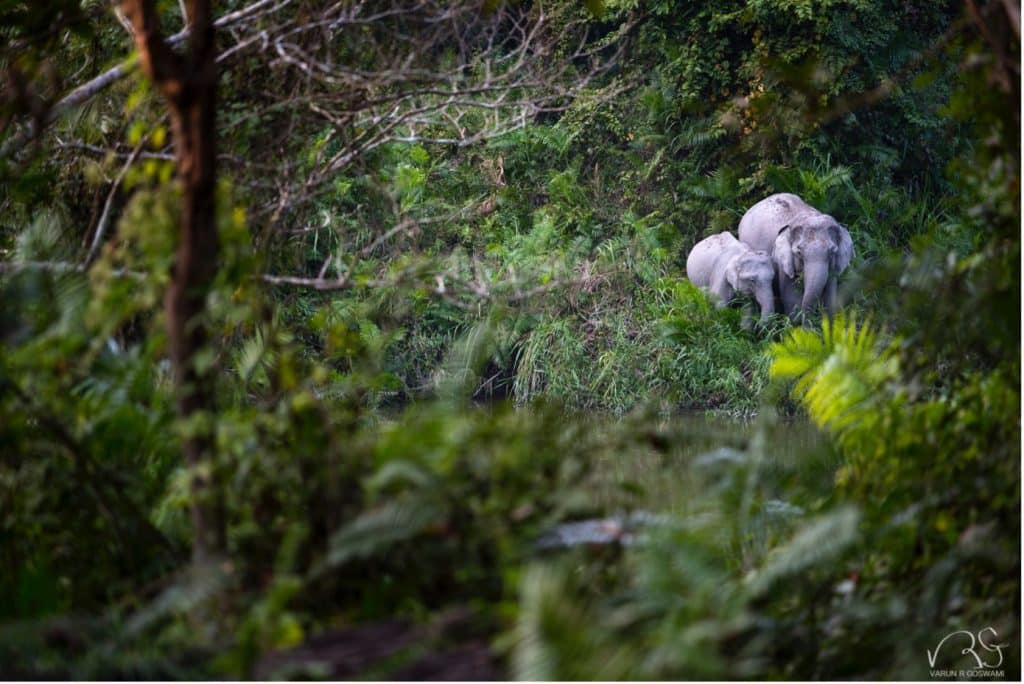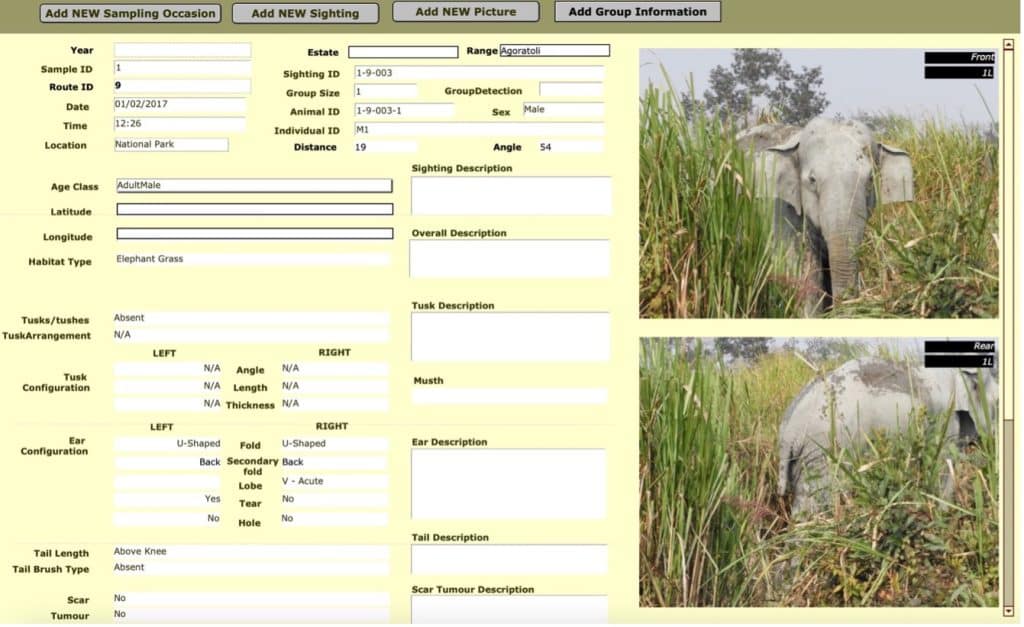A journey of conservation: Preserving elephants with FileMaker technology
Researchers in India developed an innovative photographic database to track and monitor Asian elephants, improving conservation and fostering human-wildlife coexistence.
Cathy
18 February 2025
•
 5
5
min
Industry
Non-governmental organization (NGO)
Challenge
Accurately assess and monitor the Asian elephant population to ensure a thriving elephant population and foster human-elephant coexisting across landscapes.
Solution
Comprehensive photographic database to accurately identify, track, and monitor elephants, leading to improved conservation strategies.
Benefits
- Accurate and comprehensive data
- Improved conservation strategies
- Enhanced human-elephant coexistence
In the heart of Assam, India, the Kaziranga National Park harbors one of the largest populations of Asian elephants in the world.
Here, a dedicated team of researchers has embarked on an extraordinary conservation initiative that is redefining the ways we understand and safeguard these majestic creatures.
Utilizing cutting-edge FileMaker technology, this initiative has evolved into a sophisticated and impactful approach for wildlife research and conservation, offering hope for India’s National Heritage Animal.
This is the story of how innovative strategies, and a dedicated team transformed a vision into reality, ensuring thriving elephant populations while fostering harmony with local communities.
The challenge: Balancing complexity and conservation
The Asian elephant, a majestic creature faces numerous threats and Kaziranga’s unique floodplain ecosystem, albeit a rich elephant habitat, adds complexity to their preservation.
Accurately assessing elephant numbers is crucial to understanding their population dynamics, health, and movements and to ensure effective conservation strategies.
Traditional counting methods often led to underestimation and other forms of bias, thereby missing critical insights on elephant populations.
The team needed a sophisticated system that could handle complex data while remaining practical for field researchers.
Innovative approach to elephant identification
With the pioneering efforts of Dr. Varun R. Goswami, Co-Founder and Director of a non-profit called Conservation Initiatives introduced a cutting-edge approach to elephant monitoring.
The solution to the challenge emerged in the form of a comprehensive photographic database powered by Claris FileMaker, that allows researchers to individually identify elephants and estimate population size and other key parameters using robust statistical tools. FileMaker transformed a once-cumbersome process into an efficient, streamlined workflow.
This innovative system transformed a once-cumbersome process into an efficient, streamlined workflow, unlocking unprecedented insights into elephant populations.
Recognizing that each elephant possesses a unique combination of physical characteristics – much like human facial features – the team developed a sophisticated method for individual identification. Using detailed photographs to record distinctive features such as ear shape, tusk configuration, and tail markings, they created a dynamic photographic database that paints a rich, nuanced portrait of elephant life.
This meticulous approach involves a multi-stage process:
- Comprehensive Photography: Every elephant encountered during extensive multi-year surveys is photographed.
- Database Integration: These photographs are meticulously logged into the Claris FileMaker database.
- Individual Identification: Unique characteristics are documented, creating individual profiles for each elephant.
- Population Monitoring: Information recorded in the database is combined with statistical tools to estimate elephant population and movement parameters.
- Behavioral Monitoring: Sightings, group associations, and movement patterns are recorded, enriching the individual elephant profiles.
The database comprises photographs and information on the morphological features of elephants. This allows one to identify individual elephants and keep track of their sightings over time and space. Photo credit: Conservation Initiatives.
This is far more than a simple photographic record; it’s a living, breathing database that provides crucial information on individual elephant identities, behaviors, and movements, enabling a deeper understanding of their lives and the challenges they face.
Beyond the numbers: A holistic conservation approach
The Claris FileMaker database has become an indispensable tool, enabling researchers to unlock profound insights into elephant behavior, population dynamics, and human-elephant interactions. The system provides a powerful platform for:
- Tracking elephant movements: Mapping elephant movement in the landscape and fine-scale space use.
- Long-term monitoring of individual elephants: Tracking individual elephants over multiple years provides insights into life trajectories, social dynamics, and behavioral changes.
- Population assessments: Examine population changes over time and understand the response of elephants to environmental changes.
- Understanding social dynamics: Deciphering the complex social dynamics within elephant herds, shedding light on family structures and social interactions.
- Human-elephant conflict mitigation: Assess potential human-elephant conflicts to define strategies ensuring the safety of both people and wildlife.
- Inform on-ground management: All of the above can inform on-ground management and effective design of conservation strategies.
This work extends beyond the confines of Kaziranga national park, investigating how elephants navigate human-dominated landscapes like tea estates, which serve as critical corridors connecting fragmented habitats and bringing elephants into contact with local communities.
Revolutionizing the workflow
The adoption of Claris FileMaker has revolutionized the research process, resulting in:
- Streamlined data management: The system provides streamlined data management through a centralized digital repository that organizes and stores comprehensive elephant data from photographs and precise physical characteristics, enabling efficient tracking, analysis, and retrieval.
- Accurate population estimates: Regular surveys combined with photographic identification provide reliable population estimates, crucial for assessing the health and trends of the elephant population.
- Efficiency in identification: By creating filters for specific morphological features, the software narrows down potential matches, allowing faster comparisons of photographs and reducing manual effort.
- Long-term monitoring: The database enables long-term monitoring, providing critical insights into elephant behavior and population trends over time.
- Enhanced collaboration: The database facilitates seamless global collaboration, allowing stakeholders to share and insights, and collectively contribute to elephant conservation efforts.
 FileMaker’s greatest strength is its ability to integrate all aspects of our data into a single, customizable view, making it easier for us to manage large volumes of data.
FileMaker’s greatest strength is its ability to integrate all aspects of our data into a single, customizable view, making it easier for us to manage large volumes of data.
Parvathi K. Prasad, Scientist, Conservation Initiatives
The project’s success extends beyond pure research. By training local forest staff and sharing data with relevant stakeholders, the team has fostered stronger collaboration between scientists, government agencies, and local communities. This collaborative approach leads to more effective conservation strategies and better-informed decision-making.
One of the most significant achievements of the project is its contribution to human-elephant coexistence. The team collaborated with local communities to foster coexistence and promote sustainable practices, ensuring the well-being of both humans and elephants. This collaborative approach has been instrumental in creating a harmonious relationship between wildlife and local populations, making the conservation efforts more sustainable and effective.
A new dawn for elephant conservation
What began as a research project has become a strong tool for Asian elephant research and conservation.
The work of Conservation Initiatives is a testament to the power of dedicated researchers who see numbers and beyond – who recognize that every elephant has a story, and that elephant populations matter in the grand tapestry of ecosystem preservation.
By combining cutting-edge technology, rigorous scientific methodology, and a profound respect for wildlife, this team is writing a new chapter in conservation research.
What makes this approach truly revolutionary is its potential. While currently focused on Asian elephants in Assam, the methodology could be adapted for other species, offering a blueprint for wildlife conservation worldwide.
*Cover image: A female Asian elephant with her offspring in Kaziranga National Park, Assam, India.
Photo credit: Varun R. Goswami.
Feeling inspired?
Learn more about how Claris FileMaker can help you increase efficiency in your organization – get in touch!
Let’s talk






 FileMaker’s greatest strength is its ability to integrate all aspects of our data into a single, customizable view, making it easier for us to manage large volumes of data.
FileMaker’s greatest strength is its ability to integrate all aspects of our data into a single, customizable view, making it easier for us to manage large volumes of data.